Stakes can be driven into the ground either by using the back of an axe for a maul, or if an axe is not available, a large stone, held in the two hands, and “pulled” down to the head of the stake, will drive quite effectively. When using a stone, if it is flat, use the edge rather than the flat. The edge will put more weight behind the drive, and there will be less chance of the stone breaking in two with the force of the blow. If stones of a convenient size are not available, a club with one flat face can be quickly fashioned with a tomahawk or heavy knife, and this will serve effectively.
CAMP KITCHENS
The camp kitchen should be sited so that the breeze will not blow the smoke into the cook’s face. This is quite easy when you know which direction the winds blow, both in the morning and the evening. The morning breeze (anabatic, if you want to be technical) blows up the valley, because the warm air of the valley floor rises; and the evening breeze (catabatic) blows down the valley. Therefore set your kitchen so that the cook will face neither up valley nor down valley from the fire, but sideways. Thus the smoke will blow past him, and he can cook in comfort.
The kitchen should be sited on a slight rise so that during rain it will not be flooded. The fireplace, in badly drained ground, should be built up a few inches above ground level. Select the place for your fire, and build the kitchen round it.
FIREPLACES
If stones are available, build a wall to enclose the fire. This wall should be about nine or ten inches high, and the opening should be parallel to the valley. Do not take stones from a watercourse. They will explode in the fire.
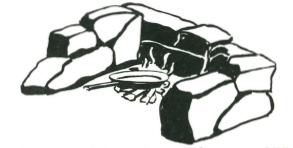
You will want a means of suspending your billies, and the most simple is a stick across the end walls.

A trench fireplace is an efficient cooking place, but only suitable in clayey soil and if there is no likelihood of flooding.
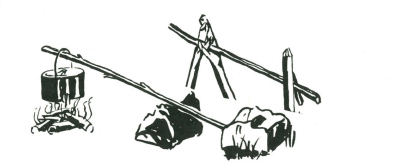
A third method is a single stick, lying over one of the end stones, and with its farther end held down either under a hooked stake or by a heavy stone.

Two simply erected tripods of interlocking forked sticks at either end, with a cross stick, is another method of suspending your billies over the fire. This latter has the advantage that, by changing the base of the tripods, the height of the billy above the flames can be varied.
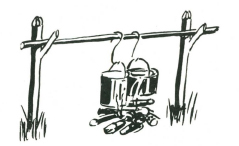
Another method to suspend your billies is by an overhead stick supported by two forked stakes driven into the ground at either end of the stone wall.

The best method of all, in a permanent camp, calls for a single straight stake driven into the ground at one side of the fireplace, and from this single stake a swinging gantry is hung. The height of the gantry on the upright stake can be adjusted to any height above the fire. It will swing free of the flames, and the billies can be taken off without burning your fingers. Although it may take five minutes to make, it will save burnt fingers and spilt or spoilt meals.

In flooded country, or in a marsh or swamp land, it may be impossible to find a spot of dry land on which to light a fire. One way to overcome this is to build a raised platform with its floor a few inches above the water level. The sticks which make the base of the platform are covered with a thick layer of mud. On this you can light your fire and cook your meal.
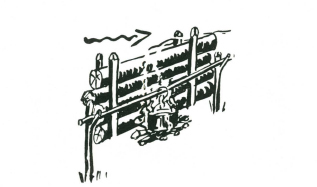
In the absence of stones, and where green wood of no value (such as sucker growth) is plentiful, a reflector fireplace may commend itself to you, particularly if the location is windy. The reflector should be on the windward side of the fire, so that the wind, passing over it, draws the flames up to the top of the reflector and then across.

When you want to boil a billy quickly in an open space in a very high wind, the flames will be blown away if, the billy is suspended. Woodsmen have a trick that is worth using under such conditions. Place the billy on the ground, and build the fire to windward and on both sides of the billy. The wind will blow the hot flames around the sides and your billy will soon boil.
BILLY HOOKS AND FIRE TONGS
All of these methods of suspending billies over a fire are improved with the use of billy hooks, and these can be easily made by cutting a few hooked sticks about half an inch in diameter, and varying in length from, say, six to ten inches. At the end farthest from the hook, a single deep nick is cut into the wood, so that the direction of the cut is away from the hook. The wire handle of the billy will sit safely in this nick and the billy stick from which the billy hooks hang will be sufficiently far from the flames so that there will be little chance of it being burnt through.
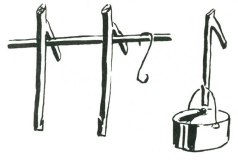
It is preferable to the the side opposite to the hook.
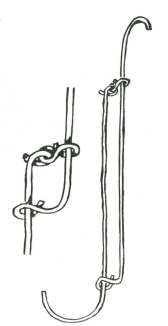
ADJUSTABLE WIRE BILLY HOOK
It is worth while making a couple of adjustable wire billy hooks if you go camping frequently. The advantages of being able to have one billy high above the flames so that it can simmer gently, and another right down over the fire to boil quickly, is apparent.
The adjustable billy hook is held at whatever height you set it by the link which locks it securely.
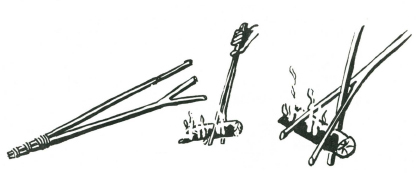
In addition to your billy stick and billy hooks, you would be well advised to make a pair of fire tongs. They will take only a few minutes, but may save a badly burnt hand.
Another improvised pair of fire tongs uses a narrow but long fork, and a single stick through its crotch.
WOODSHED
And finally, you will want to be prepared against a spell of wet weather, and so you’ll need a small woodshed. Only then will there be a supply of dry kindling and wood after heavy rain.
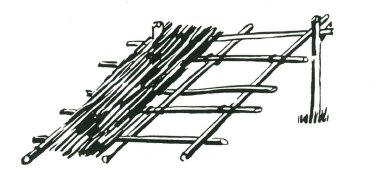
The ground dimensions of your woodshed should be at least three feet by four, and about three feet high at the front. It should be to windward of your fireplace, so that windblown sparks will not fall on dry bark or other tinder.
FIREWOOD AND FIRE IN RAIN
Firewood gathered from the ground after rain will be damp and unsuitable for a good fire. This applies to winter conditions and in rain forest, except after a long drought. It is far wiser, if you want a good fire, to pull down dead branches standing on trees for your firewood store. This wood is always reasonably dry.

When cutting thick sticks into short lengths, an easy way is to make deep cuts, opposite each other, on either side of the stick, and then, taking the stick, bring it down sharply on to a convenient log or rock, with the cut area at the point of impact. One sharp blow will generally break the wood, and you will save yourself the work of cutting right through the wood.